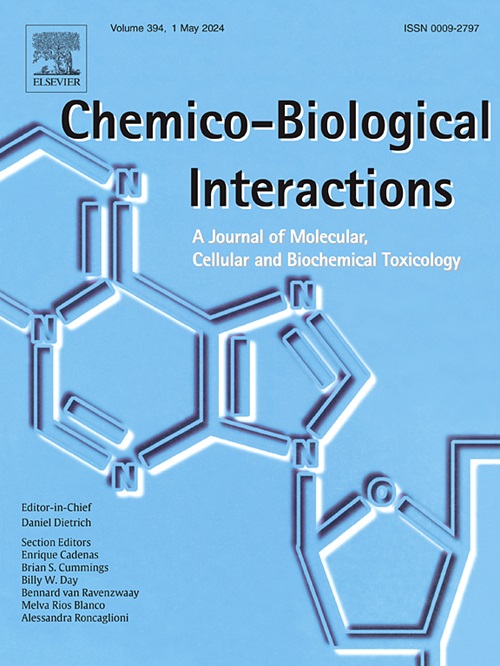YTHDF2 promotes arsenic-induced malignant phenotypes by degrading PIDD1 mRNA in human keratinocytes
IF 4.7
2区 医学
Q1 BIOCHEMISTRY & MOLECULAR BIOLOGY
引用次数: 0
Abstract
Arsenic is a widespread environmental carcinogen, and its carcinogenic mechanism has been the focus of toxicology. N6-methyladenosine (m6A) binding protein YTH domain family protein 2 (YTHDF2) performs various biological functions by degrading m6A-modified mRNAs. However, the m6A-modified target mRNA of YTHDF2 in regulating arsenic carcinogenesis remains largely unknown. To explore the effect of YTHDF2 in regulating arsenic carcinogenicity, we exposed the human keratinocyte HaCaT cells to 1 μM sodium arsenite for 50 generations to create a cell model of arsenic carcinogenesis (HaCaT-T). Our results demonstrated that YTHDF2 protein levels were higher in HaCaT-T cells than HaCaT cells, and knockdown of YTHDF2 significantly inhibited arsenic-induced malignant phenotypes. In addition, m6A levels in HaCaT-T cells were remarkably elevated, accompanied by abnormal expression of m6A methyltransferases and m6A demethylases. Mechanistically, YTHDF2 bound to p53-induced death domain protein 1 (PIDD1) mRNA in an m6A-dependent manner, thereby promoting the degradation of PIDD1 mRNA. Moreover, the decay of PIDD1 mRNA inhibited the formation of PIDDosome complex that is essential for activating the apoptosis initiator caspase-2, leading to a decrease in caspase-2-dependent mitochondrial apoptosis and subsequently promoting the malignant phenotypes of HaCaT-T cells. Collectively, our study reveals the role of YTHDF2 in arsenic-induced malignant phenotypes of human keratinocytes through direct interaction with PIDD1 mRNA in an m6A-dependent manner, which provides new insight into the precise mechanism underlying arsenic-induced skin cancer.
YTHDF2通过降解人角质形成细胞中的PIDD1 mRNA促进砷诱导的恶性表型。
砷是一种广泛存在的环境致癌物质,其致癌机制一直是毒理学研究的重点。N6-甲基腺苷(m6A)结合蛋白YTH结构域家族蛋白2(YTHDF2)通过降解m6A修饰的mRNA发挥多种生物学功能。然而,YTHDF2在调控砷致癌过程中的m6A修饰靶mRNA仍是未知数。为了探索 YTHDF2 在调控砷致癌中的作用,我们将人类角质形成细胞 HaCaT 细胞暴露于 1 μM 亚砷酸钠中 50 代,建立了砷致癌细胞模型(HaCaT-T)。我们的结果表明,HaCaT-T细胞中的YTHDF2蛋白水平高于HaCaT细胞,敲除YTHDF2能显著抑制砷诱导的恶性表型。此外,HaCaT-T 细胞中的 m6A 含量明显升高,并伴有 m6A 甲基转移酶和 m6A 去甲基化酶的异常表达。从机理上讲,YTHDF2以m6A依赖的方式与p53诱导的死亡结构域蛋白1(PIDD1)mRNA结合,从而促进了PIDD1 mRNA的降解。此外,PIDD1 mRNA的降解抑制了PIDDosome复合物的形成,而PIDDosome复合物对激活凋亡启动子caspase-2至关重要,从而导致依赖caspase-2的线粒体凋亡减少,进而促进了HaCaT-T细胞恶性表型的形成。总之,我们的研究揭示了 YTHDF2 通过与 PIDD1 mRNA 以 m6A 依赖性方式直接相互作用,在砷诱导的人类角朊细胞恶性表型中的作用,这为了解砷诱导皮肤癌的确切机制提供了新的视角。
本文章由计算机程序翻译,如有差异,请以英文原文为准。
求助全文
约1分钟内获得全文
求助全文
来源期刊
CiteScore
7.70
自引率
3.90%
发文量
410
审稿时长
36 days
期刊介绍:
Chemico-Biological Interactions publishes research reports and review articles that examine the molecular, cellular, and/or biochemical basis of toxicologically relevant outcomes. Special emphasis is placed on toxicological mechanisms associated with interactions between chemicals and biological systems. Outcomes may include all traditional endpoints caused by synthetic or naturally occurring chemicals, both in vivo and in vitro. Endpoints of interest include, but are not limited to carcinogenesis, mutagenesis, respiratory toxicology, neurotoxicology, reproductive and developmental toxicology, and immunotoxicology.

 求助内容:
求助内容: 应助结果提醒方式:
应助结果提醒方式:


